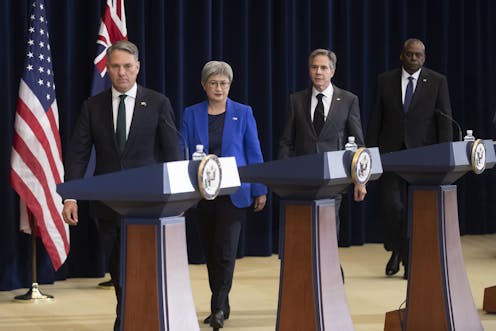Australia and US take realist approach to regional influence
- Written by Peter K. Lee, Research Fellow, Foreign Policy and Defence Program, USSC, University of Sydney

Foreign Minister Penny Wong and Defence Minister Richard Marles met with US Secretary of State Antony Blinken and Secretary of Defense Lloyd J. Austin III for the Australia-United States Ministerial Consultations (AUSMIN) in Washington, DC, on December 6.
While there is notable continuity with last year’s agenda, this year’s AUSMIN clearly bears the Albanese government’s foreign and defence policy imprint – one that has a receptive audience in the Biden administration.
With greater military co-operation, and a priority on climate action, the meeting outlines an agenda to vigorously compete with China for regional influence while advancing the alliance’s long-standing defence and security co-operation objectives.
A realist shift from 2021
There is a decidedly realist tone to this year’s AUSMIN, at least from Australia’s perspective. In her remarks at the joint press conference[1], Wong largely dispensed with talk of shared history and values. Instead, she cast AUSMIN as “the primary forum for us as an alliance […] to make progress on shared interests”.
Ideology has also taken a backseat. The emphasis on “democratic values” and human rights that occupied an entire section in last year’s joint statement has been condensed and accompanied by a more balanced assessment of China. This notes the need for responsible competition, risk reduction, and co-operation on issues of shared interest.
This year’s statement also sharpens the alliance’s focus on Australia’s region. The Pacific Islands are front and centre. There are four detailed paragraphs on how the Australia-US alliance is engaging these countries diplomatically, economically, militarily and in the maritime environment.
Read more: As APEC winds up, 'summit season' brought successes but also revealed the extent of global challenges[2]
From Wong’s relentless regional engagement[3] since taking office, to US President Joe Biden’s hosting of the first US-Pacific Islands Summit[4] in September, and both[5] countries’[6] Comprehensive Strategic Partnerships with ASEAN, Australia and the United States have clearly increased their diplomatic engagements with these two vital subregions.
The focus on maritime security co-operation with the Pacific Islands, in particular, complements similar alliance activities in South-East Asia[7], where Australia and the United States should be looking to better integrate their respective lines of effort.
By contrast, there was no reference to the Afghanistan conflict or the threat of terrorism. The statement thus reflects the conclusion of the alliance’s Middle East period.
Incremental steps in defence cooperation
As we predicted[8] last week, no new details of the AUKUS partnership were announced. However, Marles did emphasise the need to “uplift” Australia’s shipbuilding industry to meet the task. An update on export control reform was also not forthcoming, other than mentions of the need for “seamless” bilateral defence industrial co-operation.
On the alliance’s force posture initiatives, the meeting flagged some progress on key issues without making major new announcements. For instance, there will be an increase in the frequency and sophistication of US Air Force rotations through Australia, as heralded last year. By comparison, little was said about mooted US Army and Navy deployments to Australia.
Importantly, the statement identifies measures to strengthen the resilience and sustainability of combined Australia-US operations. This includes targeted logistics exercises and co-development of “agile logistics” capabilities, as well as efforts to enhance Australia’s ability to maintain and repair munitions in-country. This will be done by streamlining US technology transfer and information-sharing arrangements – measures that Marles emphasised[9] during the joint press conference[10].
Making good on these commitments will be critical to sustaining a higher tempo of joint operations in the region.
Bringing Japan on board
Perhaps the most eye-catching development is the invitation to Japan to “increase its participation in [US-Australia] Force Posture Initiatives”. Though short on specifics, this development underscores how the Australia-US alliance has become a mechanism[11] for “advancing a strategy of collective defence among other Indo-Pacific allies”.
Future years could see larger and more frequent deployments of Japan Self-Defence Forces in more sophisticated bilateral and trilateral joint exercises. These forces would include fighter aircraft[12] and marines[13] rotating through Australian facilities.
Indeed, this announcement is consistent with the trajectory of the Australia-Japan relationship set by the recently updated Joint Declaration on Security Cooperation[14]. It makes the Australia-Japan 2+2 ministerial talks scheduled for Friday in Tokyo all the more interesting. Both countries are looking to take their defence co-operation, including with the United States, to the next level[15].
Climate co-operation to the fore
Wong emphasised climate co-operation as a primary area of joint collaboration. This is not entirely novel, as “climate, clean energy and the environment” received significant attention at AUSMIN 2021[16]. There was also a brief mention in 2015[17].
Nevertheless, the framing of climate collaboration as one of three specific areas of focus (the others being engagement with South-East Asia and the Pacific Islands) reaffirms Prime Minister Anthony Albanese’s and Biden’s November statement of climate partnership as a “new pillar” of the alliance.
This is likely to be well received by domestic and regional audiences[18] alike. The 2022[19] joint statement confirms the elevation of climate, with this issue addressed in second as opposed to fourth place in 2021.
Climate efforts were also prioritised in relation to regional engagement with South-East Asia and particularly the Pacific Islands. This is a marked elevation from 2021, when climate was mentioned in less stark terms within these contexts.
Read more: Australia and the US are firm friends on defence – now let's turn that into world-beating climate action[20]
Finally, the visuals of this year’s AUSMIN were also notable. Watching the first Asian-Australian foreign minister standing alongside the first African-American secretary of defense was a poignant reminder of the power of identity in shaping bilateral narratives. Wong has often said that “foreign policy starts with who we are[21]”, and it was good to see this year’s AUSMIN reflect the diversity of our multicultural societies.
References
- ^ joint press conference (www.state.gov)
- ^ As APEC winds up, 'summit season' brought successes but also revealed the extent of global challenges (theconversation.com)
- ^ engagement (www.foreignminister.gov.au)
- ^ US-Pacific Islands Summit (www.state.gov)
- ^ both (asean.mission.gov.au)
- ^ countries’ (asean.usmission.gov)
- ^ South-East Asia (www.ussc.edu.au)
- ^ predicted (www.ussc.edu.au)
- ^ emphasised (www.aspistrategist.org.au)
- ^ joint press conference (www.youtube.com)
- ^ mechanism (www.9dashline.com)
- ^ fighter aircraft (asia.nikkei.com)
- ^ marines (www.mod.go.jp)
- ^ Joint Declaration on Security Cooperation (www.dfat.gov.au)
- ^ next level (asia.nikkei.com)
- ^ 2021 (www.dfat.gov.au)
- ^ 2015 (www.dfat.gov.au)
- ^ domestic and regional audiences (www.ussc.edu.au)
- ^ 2022 (www.dfat.gov.au)
- ^ Australia and the US are firm friends on defence – now let's turn that into world-beating climate action (theconversation.com)
- ^ foreign policy starts with who we are (www.foreignminister.gov.au)
Read more https://theconversation.com/australia-and-us-take-realist-approach-to-regional-influence-196118













